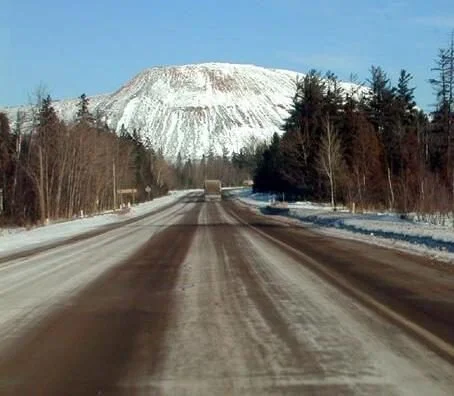The Whole Field • Volume 2 • No. 3 • Micro Full Moon • February 5th, 2023
“Genius Loci: Beach, Woods, Garden”
11" x 19" Panels • Hand-Woven Cloth, Natural Dyes, Walnut Ink, Daylily Cordage and Found Objects on Shou Sugi Ban Board • Shanna Robinson
In This Issue: Mining/Data, Lithium in Bolivia/Nevada, New Era Detroit, and Revitalize or Die.
Mountains of Data: The Physical Reality of the Virtual World
by Taylor Reed || 923 words (4 minute read)
Part One: Facts and Tilden
In this technologically pervasive society, there are gizmos to let you know where your missing keys are, and earbuds that serve as geolocators, but to my knowledge, no “fact-finders.” I wanted something that could alert me to where some information that I was looking for was. I wanted simple confirmation of one rumored fact. Too much to ask? Here’s some backstory.
The Tilden stockpile. Photo by Tom Cook, courtesy of Pasty.com.
Pure Michigan. This well-deserved tagline boasts of the abundance of natural beauty and diversity in Michigan, but one thing the state doesn’t have is the topographic grandeur of mountain ranges like the Cascades or Appalachians. It isn’t flat though. The Upper Peninsula’s Mount Curwood, a gently sloping crest amongst the Huron Mountain range, rises one-thousand, nine-hundred and seventy-eight feet above sea level. It had been considered the highest point in Michigan since sometime around the 1930s, when Governors Peak was dethroned.
In 1982, it lost its standing as the highest point in Michigan. Six miles northeast of Curwood, about halfway between Copper Harbor and Marquette, lies a patch of land owned by the American timber-giant, Weyerhaeuser. Mount Arvon, situated on that land, was surveyed at 1979.238 feet above sea level. Less than two feet higher than Curwood. Curwood, the King, the destination, is now Curwood, off-the beaten path.
Interestingly, Arvon may not even hold the title legitimately. This is the alleged fact that spurred this writing. I came across reports revealing that, technically, the highest point in Michigan is a man-made creation close to Ishpeming, rising 2,000 feet above sea level. This massive heap of rock, the Tilden stockpile, is the result of the open-pit, terraforming, behemoth Tilden mine, where ore is drilled, blasted and loaded from the earth, processed on site, and transported by rail in pelletized form to the Marquette docks. The 320-ton trucks used to shuttle the materials are the size of houses. The tires themselves are 12 feet tall. Those sound like the makings of the highest point in the state...
The Warp — Ideas and Inspiration
|| 1 || All of this talk of mining and powering facets of modern society brings to mind my high school years spent in Bolivia. Right now, the country is at a crossroads as massive deposits of hotly contested lithium rest at Salar de Uyuni, a touristy, high elevation, salty moonscape. The country has long tried to tap those reserves, but has faced difficulty as the conditions aren’t conducive to easy processing—comparable to late stage oil and natural gas extraction requiring more intensive, expensive and risky endeavors. Partnerships to extract lithium and build batteries in Bolivia have been forged with Chinese firms, and while the venture offers badly needed hope of economic boon, it also faces pushback from locals concerned with risks to the environment they draw their livelihood from. Resources like water. There’s already a powerful historical precedent when it comes to international economic policy, foreign corporations, and water in Bolivia. Here's a leftist take, an arts-related take and a PBS/New Yorker take.
There’s a similar lithium story coming to surface in Nevada. Massive mines are slated for Thacker Pass, a “stunningly biodiverse, wild, expansive, and beautiful desert in the mountains,” as well as “traditional and unceded territory of the Paiute and Shoshone people…and United States Bureau of Land Management (BLM) public land”. If ethnobotanical surveying, place-based storytelling and car-camping sound good to you, Colorado’s Groundwork is facilitating a fellowship based on documenting these lands soon to be terraformed for the Electric Vehicle future.
|| 2 || Caring for your place is important. There are many different ways of doing that. One that I like, from a series of ten suggestions Wendell Berry offered in a 1989 commencement address: “Love your neighbors—not the neighbors you pick out, but the ones you have.”
In 2014, young black men (and soon after, black women) in Detroit organized as they were fed up with cycles of violence and what they understood as a lack of care in their neighborhoods. The efforts, which they called New Era Detroit, spurred local programs reminiscent of Fred Hampton and the Black Panther’s direct care work—feeding folks, political education, and support for black-owned businesses. And also similar to Hampton and the Panther’s work, New Era’s armed patrols have brought murmurs, as other chapters have found footing in the New Era network.
As far as I can tell, those behind New Era have studied what’s worked and should be replicated from past movements. This On Being segment, “Love in Action,” with John Lewis, details some of the study, practice and discipline that went into successful nonviolent civil rights actions. These are the sorts of things New Era seems to be emphasizing—learning from patterns in the past and getting involved locally, today, to work towards better, safer futures for all.
|| 3 || There’s been a lot in here already, so I’ll keep this one short. Jeff Siegler’s community-consulting work Revitalize or Die is based on inciting civic involvement in communities. His work, reminiscent of Crosshatch-muse, Strong Towns, invites individuals to envision what a healthy home community looks like, and make decisions with that direction in mind. But that’s not always easy. Jeff’s recent post, ”Today Decisions,” briefly expounds on the difficulty, as well as value, inherent to organizations (made up of people) trying to shape their communities.
The Weft — News and Events
|| 1 || The 2023 Food and Farm Microloan Application window is closing soon. Applications are due February 7th. More information is available here.
|| 2 || Parallel 45’s Reading Series continues at the Alluvion. Find out more about four upcoming performances held at the Alluvion here. Each play reading concludes with an engaging conversation on a topic relevant to the piece, and society today, ranging from “climate change, LGBTQIA+ and immigrant rights, justice, death, spirituality, and more.” Tickets are available for a suggested donation of $20, and purchasing them ahead of time is recommended.
|| 3 || You might be wondering what’s happening with the Northern Michigan Small Farm Conference. There’s too much to detail here, but we will say that we’re excited! Click here for an update, and watch for more news in upcoming months.
|| 4 || Join MIFFS in Kalamazoo, MI, on February 25, 2023 for the 19th Annual Michigan Family Farms Conference. Workshops include topics such as: beginning bee-keeping, permaculture, finance & lending, grant brainstorming & collaboration, Farm Bill 101, farm-to-school, selling to food hubs, increasing revenue streams through food assistance programs, soil health 101, farming with a disability, branding & content marketing, and much more! Registration and information on shared transportation is available here.
|| 5 || This year’s Real Organic Symposium is tackling two complicated questions—”How Does Regenerative Differ from Organic?” and “Is Tillage Evil?”—in two sessions held a week apart, featuring insight and commentary from 30+ speakers. Read more on the particulars of these discussions, and find information on registering for the virtual summit, here.
|| 6 || Grant Opportunities
a.) Value-Added Producer Grant. Click here for dates, locations and registration notes for informational workshops on the USDA Value-Added Producer Grant. The MSU Product Center & MSU Extension/USDA Rural Development collaborations offer an opportunity to learn more about the specific requirements for the funding, which “focuses on planning for and conducting farm-based activities to create new products, expanding marketing opportunities, and increasing grower income.”
b.) Are you a farmer, rancher or forest manager? Share your vital feedback with USDA by taking a nationwide survey here. The survey is completely anonymous, will take about 10 minutes to complete, is available in multiple languages, and will be open until March 31, 2023. Also note, 2022 USDA Census of Agriculture responses are due February 6th. To find out more about the five-year questionnaire, visit the USDA’s Census of Agriculture page.
c.) If you are a farmer, or work with an organization that works with farmers, here’s an opportunity for small, short-term grants aimed at mental health and stress efforts in agriculture. Farmers can apply for this funding directly to support stress work with their employees. If you caught Remington Rice’s Northern Michigan Small Farm Conference presentation, you know how important this work can be. Learn more here.
Many thanks to the Michigan Arts & Culture Council and the National Endowment for the Arts for their support of this work.
Copyright (C) 2023 Crosshatch. All rights reserved.








